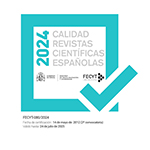La configuración territorial de los espacios residuales y del “Tercer Paisaje” en un municipio castellano-manchego, de la provincia española de Toledo: Yepes
Resumen
A lo largo de la presente investigación nos aproximamos al estudio e interpretación de los espacios residuales integrantes del denominado “tercer paisaje”, de un territorio, el que se enmarca y conforma el denominado municipio de Yepes, en la provincia castellano-manchega de Toledo (España). Su configuración territorial nos muestra cómo los elementos integradores del paisaje, en el entorno sobre el que se asientan, se pueden encuadrar o delimitar en una triple dimensión: los volúmenes y áreas, las líneas y las tramas (con doble dimensión). Las características primigenias que se perciben a la hora de valorar e interpretar el paisaje son las denominadas “visuales”, dado el carácter escénico del territorio, determinando o definiendo el atractivo del mismo. Igualmente, el espacio humanizado y su “puesta en escena” en el propio territorio, remarcan el afán del observador por descubrir el arraigo de sus gentes, el devenir de sus vidas, la razón de su existir y vivir. Todo ello sin olvidar que, las no siempre positivas externalidades generadas por el planeamiento, tienen consecuencias; sirvan como ejemplo, las iniciativas privadas de la mano del ocio, las cuales generan construcciones de poco valor urbanístico que, tras el paso de los años, y el cese de actividad, quedan reducidas a espacios residuales. De esta forma si los espacios urbanos o los suburbios de las ciudades, de los pueblos,…, recogen las huellas del pasado, procesos que pueden medirse y tienen límites definidos y perceptibles (generan espacios discontinuos, en principio, cerrados, estáticos, pueden forman composiciones seriales). Aparecen, igualmente, los denominados “antiespacios”; territorios informes, continuos, carentes de bordes formales perceptibles. Como consecuencia, los espacios residuales acaban generando unas realidades, poco o nada estéticas, de dudosa ética, especialmente importantes en el caso de Yepes.
Descargas
Descarga artículo
Licencia
La revista Anales de Geografía de la Universidad Complutense, para fomentar el intercambio global del conocimiento, facilita el acceso sin restricciones a sus contenidos desde el momento de su publicación en la presente edición electrónica, y por eso es una revista de acceso abierto. Los originales publicados en esta revista son propiedad de la Universidad Complutense de Madrid y es obligatorio citar su procedencia en cualquier reproducción total o parcial. Todos los contenidos se distribuyen bajo una licencia de uso y distribución Creative Commons Reconocimiento 4.0 (CC BY 4.0). Esta circunstancia ha de hacerse constar expresamente de esta forma cuando sea necesario. Puede consultar la versión informativa y el texto legal de la licencia.












